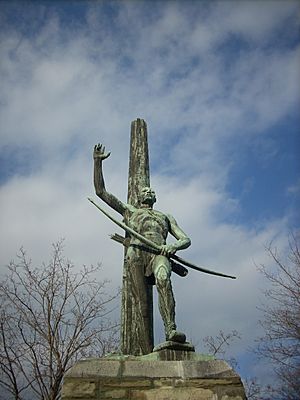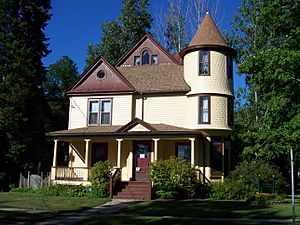Painted Post, New York facts for kids
Quick facts for kids
Painted Post
|
|
|---|---|
|
Village
|
|

A monument to the Seneca Indians in Painted Post
|
|
| Country | United States |
| State | New York |
| County | Steuben |
| Area | |
| • Total | 1.33 sq mi (3.46 km2) |
| • Land | 1.27 sq mi (3.30 km2) |
| • Water | 0.06 sq mi (0.16 km2) |
| Elevation | 942 ft (287 m) |
| Population
(2020)
|
|
| • Total | 1,768 |
| • Density | 1,387.76/sq mi (535.75/km2) |
| Time zone | UTC-5 (Eastern (EST)) |
| • Summer (DST) | UTC-4 (EDT) |
| ZIP Code |
14870
|
| Area code(s) | 607 |
| FIPS code | 36-56088 |
| GNIS feature ID | 0959764 |
| Website | http://villageofpaintedpost.com/ |
Painted Post is a small village located in Steuben County, New York. It's part of the town of Erwin, just west of the city of Corning. In 2010, about 1,809 people lived there. The village gets its unique name from a special wooden post that was found by early explorers where three rivers meet. This post was important to the Seneca people.
The Corning-Painted Post Airport (7N1) is located west of the village. The former town of Painted Post was renamed the town of Corning in 1836.
Contents
History of Painted Post
The Mysterious Post
The name "Painted Post" comes from a historic wooden post. This post was found in the area in the late 1700s. The Seneca people had a word for the area, "TKäen DōD," which meant "land of the post."
Some stories say the post was not originally painted. It might have been used like a bulletin board by the Seneca people. When white settlers arrived, they painted it. For the Seneca people, painting this post was seen as disrespectful.
Village Beginnings
Village records show that Painted Post was established as a village in 1803. The Erwin brothers were among the first wealthy European settlers in the area. The town of Erwin, where Painted Post is located, was named after them in 1796. You can still see the four mansions built by the Erwin brothers today.
The village was first officially formed in 1860. It was re-incorporated in 1893. The exact reason for the post and its origin are still debated. A drawing of the post can be seen on a map from 1796.
Stories Behind the Name
There are different stories about how the "Painted Post" got its name. One story from 1779 tells of a group of loyalists and Native Americans returning from a trip. A Seneca chief named Captain Montour was badly hurt. He died near where the Tioga and Cohocton Rivers meet.
His friends buried him by the river. They placed a post above his grave with symbols painted on it. This monument became known as "The Painted Post." It was a famous landmark for the Six Nations people.
Another story says the post was put up for a brave warrior. This warrior was hurt in a battle during the Revolutionary War. He was brought by canoe to this spot, where he later died. The post stood for many years after settlers arrived. It was said to have been kept in a tavern for a while before it disappeared around 1810. Some also say it was washed away in a flood.
Major Flood Event
In June 1972, a big storm called Hurricane Agnes caused severe flooding. It dropped a lot of rain, up to 20 inches (500 mm), in the Chemung Valley. The Chemung, Tioga, and Cohocton rivers all overflowed. This left many areas of Painted Post, Corning, Big Flats, and Elmira underwater. Many bridges were also destroyed.
Cultural Connections
Painted Post is mentioned in a poem called "American Names" by Stephen Vincent Benét.
Several historic buildings in Painted Post are listed on the National Register of Historic Places. These include the First Baptist Church of Painted Post, the Delaware, Lackawanna & Western Railroad Station, and the United States Post Office. The post office has a mural inside called Recording the Victory. It was painted by Amy Jones in 1939. This mural was part of a government program to create art during the 1930s and 1940s.
Geography
Location and Rivers
According to the United States Census Bureau, the village covers about 1.3 square miles (3.4 km2). Most of this area is land, with a small part being water.
New York State Route 415 runs through the village. Painted Post is also near the Southern Tier Expressway and the Cohocton River. Interstate 86 also passes through Painted Post. It continues all the way to Jamestown.
Population Information
| Historical population | |||
|---|---|---|---|
| Census | Pop. | %± | |
| 1880 | 701 | — | |
| 1890 | 688 | −1.9% | |
| 1900 | 775 | 12.6% | |
| 1910 | 1,224 | 57.9% | |
| 1920 | 2,170 | 77.3% | |
| 1930 | 2,328 | 7.3% | |
| 1940 | 2,337 | 0.4% | |
| 1950 | 2,405 | 2.9% | |
| 1960 | 2,570 | 6.9% | |
| 1970 | 2,496 | −2.9% | |
| 1980 | 2,196 | −12.0% | |
| 1990 | 1,950 | −11.2% | |
| 2000 | 1,842 | −5.5% | |
| 2010 | 1,809 | −1.8% | |
| 2020 | 1,768 | −2.3% | |
| U.S. Decennial Census | |||
As of the census in 2000, there were 1,842 people living in the village. There were 811 households and 480 families. The population density was about 1,457 people per square mile (562.5/km2).
About 27.6% of households had children under 18 living with them. The average household size was 2.26 people. The average family size was 2.97 people.
The population was spread out by age. About 23.9% were under 18 years old. About 21.7% were 65 years or older. The average age was 42 years.
Education
Public schools in Painted Post are managed by the Corning-Painted Post Area School District. This district is also known as the Corning City School District. Schools located in Painted Post include Corning-Painted Post Middle School, Calvin U. Smith, and Erwin Valley.
Notable People
Many interesting people have connections to Painted Post:
- W. Sterling Cole, a former US Congressman.
- Willard Nelson Clute, a famous botanist, was born here.
- Charles B. Farwell, a Chicago merchant, banker, and politician.
- William Spring Hubbell, another former US Congressman.
- Thomas J. Watson, the founder of IBM, a major technology company.
See also
 In Spanish: Painted Post para niños
In Spanish: Painted Post para niños



